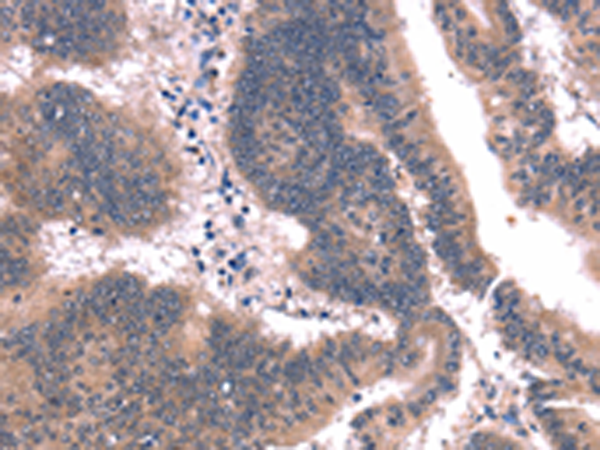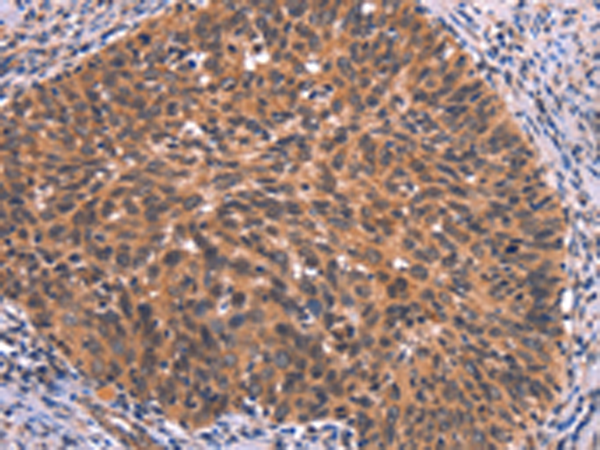


| WB | 咨询技术 | Human,Mouse,Rat |
| IF | 咨询技术 | Human,Mouse,Rat |
| IHC | 1/25-1/100 | Human,Mouse,Rat |
| ICC | 技术咨询 | Human,Mouse,Rat |
| FCM | 咨询技术 | Human,Mouse,Rat |
| Elisa | 1/1000-1/2000 | Human,Mouse,Rat |
| Aliases | FAIM1 |
| WB Predicted band size | 20 kDa |
| Host/Isotype | Rabbit IgG |
| Antibody Type | Primary antibody |
| Storage | Store at 4°C short term. Aliquot and store at -20°C long term. Avoid freeze/thaw cycles. |
| Species Reactivity | Human, Mouse, Rat |
| Immunogen | Synthetic peptide of human FAIM |
| Formulation | Purified antibody in PBS with 0.05% sodium azide and 50% glycerol. |
+ +
以下是关于FAIM抗体的3篇参考文献,包含文献名称、作者及摘要内容概括:
---
1. **文献名称**:*FAIM is an anti-apoptotic molecule that protects innate B cells from death by endoplasmic reticulum stress*
**作者**:Segundo-Val, I. S. et al.
**摘要**:该研究揭示了FAIM蛋白在抑制内质网应激诱导的B细胞凋亡中的作用。作者通过生成FAIM特异性抗体,证实其在小鼠模型中的表达可增强B细胞存活,并参与调控未折叠蛋白反应(UPR)通路。
---
2. **文献名称**:*Fas Apoptotic Inhibitory Molecule (FAIM) promotes glioblastoma progression by modulating the PI3K/Akt pathway*
**作者**:Chen, L. et al.
**摘要**:研究利用FAIM抗体进行免疫组化及Western blot分析,发现FAIM在胶质母细胞瘤中高表达,并通过激活PI3K/Akt信号通路促进肿瘤细胞增殖和侵袭,提示FAIM抗体可作为潜在治疗靶点检测工具。
---
3. **文献名称**:*Characterization of a novel monoclonal antibody against FAIM-S for detecting oxidative stress-induced neuronal apoptosis*
**作者**:Kim, J. H. et al.
**摘要**:该研究开发了一种针对FAIM-S亚型的新型单克隆抗体,验证其在氧化应激诱导的神经元凋亡模型中的特异性。抗体成功应用于流式细胞术和免疫荧光,证实FAIM-S在凋亡调控中的关键作用。
---
**备注**:FAIM抗体相关研究相对较少,以上文献聚焦于其在凋亡、肿瘤及神经系统疾病中的机制和应用。建议通过PubMed或Web of Science以“FAIM antibody”为关键词进一步检索最新进展。
The Fas Apoptosis Inhibitory Molecule (FAIM) is a protein that plays a critical role in regulating cell survival by inhibiting Fas-mediated apoptosis. Discovered in 1999. FAIM counteracts the pro-apoptotic signals initiated when Fas (CD95), a death receptor, binds to its ligand (FasL). This interaction typically triggers the assembly of the death-inducing signaling complex (DISC), activating caspases and leading to programmed cell death. FAIM interferes with this process, promoting cell survival under physiological and pathological conditions. Two isoforms exist: FAIM-S (short, ubiquitously expressed) and FAIM-L (long, neuron-specific). FAIM-L is implicated in neuronal survival, with studies linking its dysregulation to neurodegenerative diseases like Alzheimer’s.
FAIM antibodies are essential tools for studying these mechanisms. They enable detection of FAIM expression levels, subcellular localization, and interactions with apoptotic signaling components (e.g., FADD, caspases). Researchers use FAIM antibodies in Western blotting, immunohistochemistry, and co-immunoprecipitation to explore its roles in cancer, autoimmunity, and neurodegeneration. For instance, FAIM is often downregulated in cancers to evade apoptosis, while its overexpression in autoimmune disorders may contribute to pathogenic cell survival. These antibodies also aid in evaluating FAIM’s therapeutic potential as a target for modulating apoptosis in disease contexts. Overall, FAIM antibodies are pivotal in elucidating the balance between cell survival and death, offering insights into disease mechanisms and treatment strategies.
×